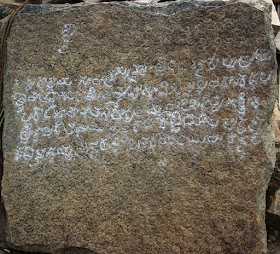Every
day I travel from Bangalore city to electronics city (pun intended). You’ve no
idea how exasperating it is to cross silk board junction, if you haven’t
experienced it by yourself. I have vented out my frustration on silk board
traffic by means of innumerable Facebook status and tweets. But yesterday was
different. I had not envisaged that a day will come where I’ll be all excited
about crossing silk board. The reason: I was visiting a small village alongside
Hosur road called “Begur” which had made it to the headlines. Thanks to the
excavation of an old inscription on a piece of rock in the 1000 year old “Naganatheswara” temple. Etched on the inscription
is the phrase which caught my attention.
This article originally appeared on Huffingtonpost. Read it here
“Bengaluru
kalaghadhol buttana setti sattam” (In kannada “ಬೆಂಗಳೂರು ಕಾಳಗಧೊಳ್ ಬುಟ್ಟಣ ಶೆಟ್ಟಿ ಸತ್ತಂ”) *1 It translates to English as “In the Battle of Bangalore, Buttana Setti died”.
About the temple
This Shiva temple with two gopuras (monumental
towers) is said to be at least 1100 years old. It is constructed during the
reign of Cholas. The main sanctum sanctorum has a shivalinga idol inside and a
Nandi outside, as it is seen all the other Shiva temples of yesteryears. Localites
worship Shiva with the name Nageshwara and/or Naganatheshwara.
 |
| Two gopuras - View from east |
Interestingly
the design and architecture of this thousand year old “Naganatheshwara temple” is entirely synonymous with the
architecture of Gangaikonda Cholapuram, a small town in Tamil nadu, the then
Capital of Cholas. Apparently, the Cholas ruled south India during 11th
century AD and the inscription found in the Naganatheshwara
temple in Begur also dates back to around same time period, according to
epigraphists.
Bengaluru war
One of the hero stones found at the temple site,
veeragallu, as we call it in the
vernacular language has the inscription in which the reference to “Bangalore
War” is made in old kannada (haLeGannada).
According to epigraphist R Narasimhachar, the inscription dates back to circa
890 AD *2. The inscription is also entered into the “Epigraphia Carnatica” a book on
epigraphy on old Mysore (now Karnataka) regions written by B L Rice.
What it means to
Bangalore
Until now, the evidence of the existence of a
place called “Bengaluru” was
available only with the onset of ruler Kempegowda II in early 1500s. But with
this inscription, the earliest existence of namma Bengaluru dates back to 890
AD. Not only this, this inscription has also raised questions on the
authenticity of the theories that describe how Bengaluru got its name.
Historians are revisiting the “Benda-Kalooru”, “bengaval-ooru” theories. Although
the complete history of Bengaluru city is still nondescript, excavations like
this has helped give a new past to namma Bengaluru. Historians and
archaeologists are working on extricating the city’s history.
On one hand, with so much of political apathy, bad
governance and millions of uninviting civic problems, Bangalore’s future looks dismal.
On the other hand, with such excavations, Bangalore’s past is getting more
enriching and enthralling. In a classical sense, the past is giving Bangalore
its true identity. Let us hope that future will hold on to it.
*1 – Article on Hindu Newspaper http://www.thehindu.com/features/friday-review/history-and-culture/a-citys-secrets-etched-in-stone/article3254183.ece
* 2 – Nagesvara temple
in Belur - Wikipedia This article originally appeared on Huffingtonpost. Read it here



